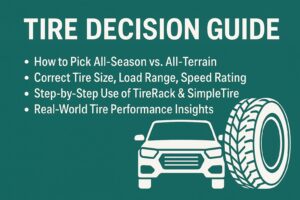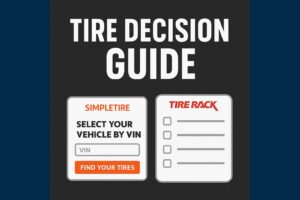Choosing new tires for your truck or SUV can be confusing—but it doesn’t have to be. Tools like TireRack’s Tire Decision Guide and SimpleTire’s SimpleScore System make it easier, but each works best in different ways.
As a former Bridgestone field test engineer, I’ve helped hundreds of drivers find the right tire—not just the most popular one. In this article, I’ll walk you through a step-by-step decision process backed by both platforms and share Reddit-tested insights to help you avoid common mistakes.
🔎 Summary: What This Tire Decision Guide Covers
This guide walks you through:
How to find the right tire size, load range, and speed rating
The difference between TireRack’s lab-tested results and SimpleTire’s quick scoring system
Real-world performance insights from Reddit users
Internal tips from 10+ years of field testing experience
Why daily drivers, off-roaders, and towing vehicles need different priorities
🚀 Want to skip ahead and get personalized tire picks right now?
Try the TireRack Tire Decision Guide — it filters options based on how you drive, where you drive, and what you actually care about.
👉 It’s the most accurate tire-matching tool for performance-focused buyers.
Table of Contents
🔍 Step 1: Start with the Right Tire Size — Don’t Guess
You have 3 ways to find your correct tire specs:
✅ Option A: Check your current tires
Look at the sidewall. You’ll see something like P265/65R18 114T.
✅ Option B: Use your VIN
SimpleTire lets you enter your VIN to instantly pull up OE tire specs.
→ Find Tires by VIN
✅ Option C: Use your vehicle’s make/model/year
TireRack and SimpleTire both support this, but TireRack will also ask for trims and OE vs plus-size info.
🧠 Step 2: Prioritize Your Driving Needs — This Is Where Most People Go Wrong
Too many people skip this and just pick by brand or price.
Ask yourself:
Is comfort or traction more important?
Do I face snow or mostly dry roads?
Am I towing or hauling?
How much do I care about tire noise?
Now let’s enter that into each tool.
🧪 Step 3: Use TireRack for Test-Based Prioritization
TireRack walks you through a detailed set of questions:
✅ Driving environment (wet, snow, dry, etc.)
✅ Ride comfort vs performance
✅ Longevity vs traction
✅ Budget range
From there, it recommends tires based on real test data, not just reviews.
You’ll get access to:
Wet/dry braking distance
Road noise test
Ice and snow performance
Example:
“I used the Michelin Defender 2 for daily commuting. Awesome in dry, but it was sketchy in light snow. Switched to CrossClimate2—much better.”
— u/mikeyonthemove, Reddit
A side note here: Use TireRack Test Reports if you’re comparing high-end options and want proof behind the price.
🟢 Step 4: Use SimpleTire for Fast Comparison and Added Perks
SimpleTire simplifies everything with its SimpleScore system, rating each tire on:
Traction
Longevity
Handling
You’ll also see highlights like:
“Great for wet grip”
“Long tread life for the price”
“Recommended for snow zones”
Bonus:
SimpleTire often includes:
Free shipping
Road hazard coverage
Price match guarantee
→ Do A/T Tires Last Long?
Reddit quote example:
“SimpleTire helped me find a tire that was half the cost of a KO2, and I didn’t need that much off-road grip anyway.”
— u/walktofreedom
🧱 Step 5: Consider These Additional Factors (Most Tools Don’t Ask These)
Even the best decision tools won’t catch:
Make sure you match tire strength, sidewall, and wear pattern to how (and where) you actually drive.
| Feature | TireRack | SimpleTire |
|---|---|---|
| VIN Search | ❌ No | ✅ Yes |
| Prioritized Q&A Tool | ✅ Yes (deep filtering) | ✅ Yes (basic use case only) |
| Real Test Data | ✅ Yes (lab + track tested) | ❌ No |
| Simple Performance Scoring | ❌ No | ✅ Yes (SimpleScore) |
| Extra Perks (shipping, etc.) | ⚠️ Some (installer finder) | ✅ Many (shipping, warranty) |
| Best For | Data-driven buyers | Everyday shoppers |
🏁 Verdict:
Use TireRack if you want detailed tests and tight comparisons
Use SimpleTire if you want faster decisions and better pricing perks
🎯 Final Tips Before You Buy
✔️ Replace tires near 4/32″ (wet safety risk)
✔️ Prioritize the worst condition you’ll face, not your average commute
✔️ Know how to rotate & care for your new tires:
→ How to Make Tires Last Longer
→ Can I Replace Just One Tire?



